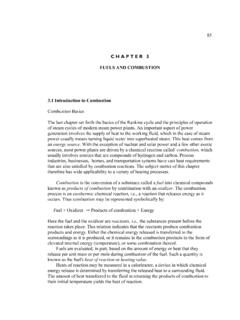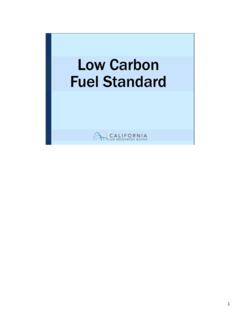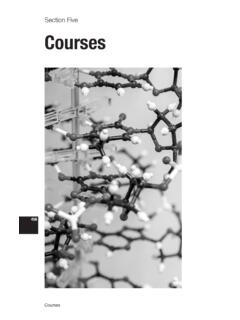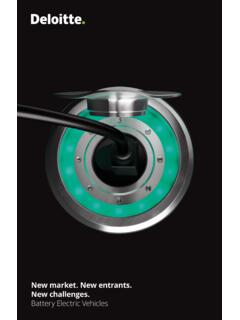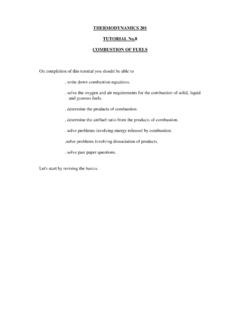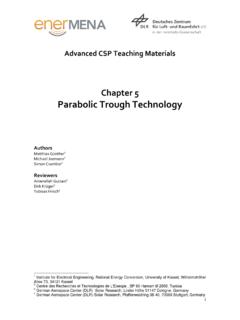Transcription of COAL CHARACTERISTICS - Purdue University
1 CCTR Indiana Center for Coal Technology Research COAL CHARACTERISTICS . CCTR Basic Facts File # 8. Brian H. Bowen, Marty W. Irwin The Energy Center at Discovery Park Purdue University CCTR, Potter Center, 500 Central Drive West Lafayette, IN 47907-2022. Email: October 2008 1. Indiana Center for Coal Technology Research CCTR COAL FORMATION. As geological processes apply pressure to peat over time, it is transformed successively into different types of coal Source: Kentucky Geological Survey 20&hl=en&start=5&um=1&tbnid=NavOy9_5HD07 pM:&tbnh=82&tbnw=134&prev=/images%3Fq%3 Dcoal%2 Bphotos%26svnum%3D10%26um%3D1%26hl%3 Den%26sa%3DX. 2. Indiana Center for Coal Technology Research CCTR. COAL analysis . Elemental analysis of coal gives empirical formulas such as: C137H97O9NS for Bituminous Coal C240H90O4NS for high-grade Anthracite Coal is divided into 4 ranks: (1) Anthracite (2) Bituminous (3) Sub-bituminous (4) Lignite Source: 3.
2 Indiana Center for Coal Technology Research CCTR. BITUMINOUS COAL. Bituminous Coal: Great pressure results in the creation of bituminous, or soft coal. This is the type most commonly used for electric power generation in the It has a higher heating value than either lignite or sub-bituminous, but less than that of anthracite. Bituminous coal is mined chiefly in the Midwest & Appalachia 38&hl=en&start=1&um=1&tbnid=ZKBL7apLynZM cM:&tbnh=104&tbnw=121&prev=/images%3Fq%3 Dcoal%2 Bphotos%26svnum%3D10%26um%3D1%26hl%3 Den%26sa %3DX. 4. Indiana Center for Coal Technology Research CCTR. ANTHRACITE COAL. Anthracite: Sometimes also called hard coal, . anthracite forms from bituminous coal when great pressures developed in folded rock strata during the creation of mountain ranges. This occurs only in limited geographic areas primarily the Appalachian region of Pennsylvania.
3 Anthracite has the highest energy content of all coals & is used for making coke, a fuel used in steel foundry ovens 38&hl=en&start=1&um=1&tbnid=ZKBL7apLynZM cM:&tbnh=104&tbnw=121&prev=/images%3Fq%3 Dcoal%2 Bphotos%26svnum%3D10%26um%3D1%26hl%3 Den%26sa %3DX. 5. Indiana Center for Coal Technology Research CCTR. COAL RANK. Anthracite coal is a dense, hard rock with a jet- black color & metallic luster. It contains between 86% and 98% carbon by weight, & it burns slowly, with a pale blue flame & very little smoke Bituminous coal (in Indiana), contains between 69% & 86% carbon by weight Sub-bituminous coal contains less carbon, more water & is a less efficient source of heat Lignite coal, or brown coal, is a very soft coal that contains up to 70% water by weight. Emits more pollution than other coals Source: 6.
4 Indiana Center for Coal Technology Research CCTR. COAL COMPONENTS. Volatile matter consists of aliphatic carbon atoms (linked in open chains) or aromatic hydrocarbons (one or more six-carbon rings characteristic of benzene series) and mineral matter Ash consists of inorganic matter from the earth's crust:- limestone, iron, aluminum, clay, silica, and trace elements (concentrations of less than 1000 ppm [< of a rock's composition] of zinc, copper, boron, lead, arsenic, cadmium, chromium, selenium). 7. Indiana Center for Coal Technology Research CCTR. COAL PHYSICAL PARAMETERS. Each type of coal has a certain set of physical parameters which are mostly controlled by (a) moisture (b) volatile content (aliphatic or aromatic hydrocarbons) &. (c) carbon content Aliphatic - designating a group of organic chemical compounds (carbon compounds) in which the carbon atoms are linked in open chains Aromatic - containing one or more six-carbon rings characteristic of the benzene series Hydrocarbons - numerous organic compounds, such as benzene &.
5 Methane, that contain only carbon & hydrogen 8. Indiana Center for Coal Technology Research CCTR. CARBON IN COAL. Carbon forms more than 50% by weight &. more than 70% by volume of coal (this includes inherent moisture). This is dependent on coal rank, with higher rank coals containing less hydrogen, oxygen & nitrogen, until 95% purity of carbon is achieved at Anthracite rank & above Graphite formed from coal is the end-product of the thermal & diagenetic conversion (process of chemical & physical change in deposited sediment during its conversion to rock) of plant matter (50% by volume of water) into pure carbon 9. Indiana Center for Coal Technology Research CCTR. COAL VOLATILE MATTER. Volatile matter is material that is driven off when coal is heated to 950 C (1,742 F) in the absence of air under specified conditions - components of coal, except for moisture, which is liberated usually as a mixture of short & long chain hydrocarbons, aromatic hydrocarbons & some sulphur - measured practically by determining the loss of weight Consists of a mixture of gases, low-boiling-point organic compounds that condense into oils upon cooling, & tars.
6 Volatile matter decreases as rank increases 10. Indiana Center for Coal Technology Research CCTR. COAL VOLATILE MATTER. 11. Indiana Center for Coal Technology Research CCTR. SULFUR IN COAL. Although coal is primarily a mixture of carbon (black). & hydrogen (red) atoms, sulfur atoms (yellow) are also trapped in coal, primarily in two forms. In one form, (1) the sulfur is a separate particle often linked with iron (green, pyritic sulfur) with no connection to the carbon atoms, as in the center of the drawing (fools gold). In the second form, (2) sulfur is chemically bound to the carbon atoms (organic sulfur), such as in the upper left Source: 12. Indiana Center for Coal Technology Research CCTR. COAL TYPICAL CONTENT. % weight Anthracite Bituminous Sub- Lignite Bituminous Heat Content 13,000-15,000 11,000-15,000 8,500-13,000 4,000-8,300.
7 (Btu/lb). Moisture < 15% 2 - 15% 10 - 45% 30 - 60%. Fixed Carbon 85 - 98% 45 - 85% 35 - 45% 25 - 35%. Ash 10 - 20% 3 - 12% 10% 10 - 50%. Sulfur - < 2% Chlorine (ppm) 340 40ppm 340 ppm 120 20ppm 120 20ppm 13. Indiana Center for Coal Technology Research CCTR. COAL TYPES. Geologists also classify coal types according to the organic debris, called macerals, from which the coal is formed. Macerals (microscopic organic constituents found in coal) are identified (microscopically) by reflected light - the reflective or translucent properties of the coal indicating the individual component macerals & the way they have combined to form the coal The purpose of classifying coal in this way is to determine its best uses. Mineral content is assessed by burning coal &. measuring the amount of incombustible material remaining, referred to as the ash content of coal 14.
8 Indiana Center for Coal Technology Research CCTR. COAL RANK. The degree of 'metamorphism' or coalification undergone by a coal, as it matures from peat to anthracite, has an important bearing on its physical and chemical properties, & is referred to as the 'rank' of the coal Volatile matter, H2 , O2 , N. HIGH Moisture Content Carbon/Energy Content HIGH. Low Rank Coal High Rank Coal #types 15. Indiana Center for Coal Technology Research CCTR. COAL PARAMETER VARIATIONS WITH RANK. Generally the moisture content increases with decreasing rank & ranges from 1 to 40%. Moisture content is determined by heating an air-dried coal sample at 105 110 C. (221 230 F) under specified conditions until a constant weight is obtained Volatile matter is material that is driven off when coal is heated to 950 C (1,742 F) in the absence of air under specified conditions.
9 It is measured Increasing Rank practically by determining the loss of weight Source: American Iron and Steel Institute, 16. Indiana Center for Coal Technology Research CCTR. COAL PARAMETER VARIATIONS WITH RANK. The fixed carbon content of the coal is the carbon found in the material which is left after volatile materials are driven off. This differs from the ultimate carbon content of the coal because some carbon is lost in hydrocarbons with the volatiles Increasing Rank Calorific value, measured in Btu is the amount of chemical energy INDIANA. stored in a coal that is released as thermal energy upon combustion . It is directly related to rank Vitrinite is a type of maceral. Vitrinite reflectance can be used as an indicator of maturity in hydrocarbon source rocks Source: American Iron and Steel Institute, 17.
10 Indiana Center for Coal Technology Research CCTR. COAL SIZES. COARSE COAL > ( 1 inch). SMALL COAL FINE COAL < ( inch). ULTRA FINE COAL < ( inch). 18. Indiana Center for Coal Technology Research CCTR HEATING VALUE. (Btu/lb dry) OF THE. INDIANA. Sullivan DANVILLE COAL. The heating value shows the amount of energy that is in the coal & is the most Knox important coal parameter for economic benefits & highest engineering efficiencies Higher heat Gibson value in Knox Higher heat value in Knox County than in County than in Posey. Posey Posey County Indiana & Midwest coals have high energy values Source: M. Mastalerz, A Drobniak, J. Rupp and N. Shaffer, Assessment of the Quality of Indiana coal for Integrated Gasification Combined Cycle Performance (IGCC)', Indiana Geological Survey, Indiana University , June 2005 19.

